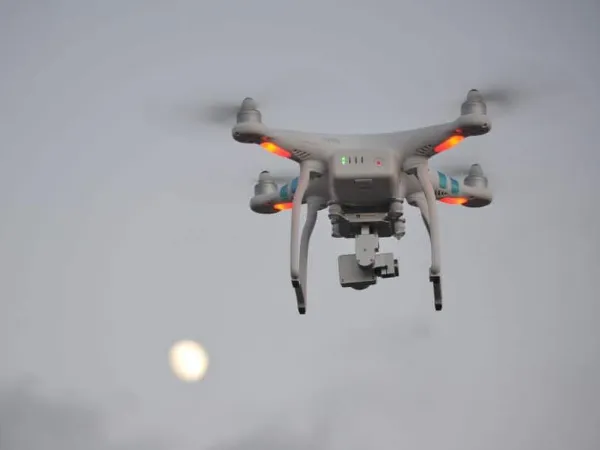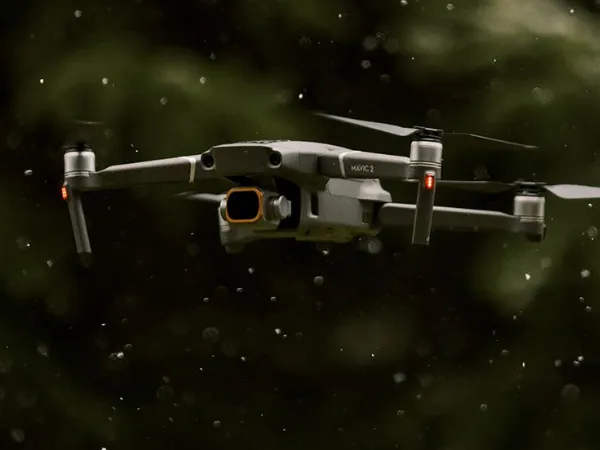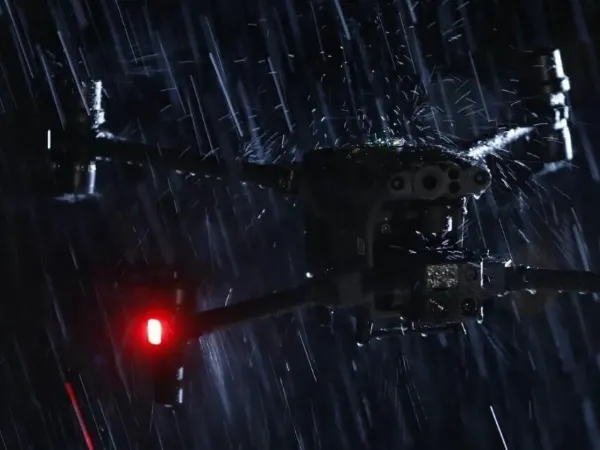Can Drones Fly in Rain: Navigating Rainy Skies!

Drones, also known as unmanned aerial vehicles (UAVs), have become increasingly popular for various applications, ranging from photography and videography to agriculture and search and rescue operations. While they offer an array of benefits, many drone enthusiasts and professionals wonder if these small aircraft can operate effectively in adverse weather conditions, particularly rain. In this article, we will explore the capabilities and limitations of drones Can drones fly in rain?
Contents
The Basics of Drone Technology
Before we delve into the query “Can Drones Fly in Rain“, we must understand the fundamental components of these remarkable flying machines. A typical drone is composed of various parts, including:
1. Frame and Propellers
The frame serves as the structure that holds all the components together, while the propellers are responsible for generating the thrust necessary for flight.
Auto Amazon Links: No products found. No products found. http_request_failed: A valid URL was not provided. URL: https://ws-na.amazon-adsystem.com/widgets/q?SearchIndex=All&multipageStart=0&multipageCount=20&Operation=GetResults&Keywords=Samsung+Galaxy+s23|Galaxy+s23|SAMSUNG+Galaxy+S23+Ultra+Cell+Phone|Drones|Can+Drones+Fly+in+Rain%3A+Navigating+Rainy+Skies%21&InstanceId=0&TemplateId=MobileSearchResults&ServiceVersion=20070822&MarketPlace=US Cache: AAL_efda297e24ce285e99c92f2457609afa
2. Motors and Power Source
Drones are equipped with electric motors powered by rechargeable batteries, which provide the energy required for takeoff, flight, and landing.
3. Flight Controller
The flight controller is the brain of the drone, managing all the flight parameters and ensuring stability and control.
4. Sensors
Drones use a variety of sensors, such as accelerometers, gyroscopes, GPS, and altimeters, to maintain their position, altitude, and orientation.
5. Camera and Payload
Many drones are equipped with cameras or other payload systems for specific tasks, like photography, video recording, or data collection.

With this basic understanding, let’s examine how these components can be affected by rain.
The Impact of Rain on Drones
Rain, with its moisture and potential for precipitation, can pose several challenges to drones. Here are the main factors to consider:
Auto Amazon Links: No products found. No products found. http_request_failed: A valid URL was not provided. URL: https://ws-na.amazon-adsystem.com/widgets/q?SearchIndex=All&multipageStart=0&multipageCount=20&Operation=GetResults&Keywords=Drones|Galaxy+s23|Can+Drones+Fly+in+Rain%3A+Navigating+Rainy+Skies%21|Samsung+Galaxy+s23|SAMSUNG+Galaxy+S23+Ultra+5G&InstanceId=0&TemplateId=MobileSearchResults&ServiceVersion=20070822&MarketPlace=US Cache: AAL_9bda73b56add641f306edec1ee154848
1. Electrical Components
Drones rely heavily on electrical components such as motors, batteries, and circuitry. Rainwater can seep into these parts and potentially cause a short circuit or damage the sensitive electronics. The water can also affect the performance of the batteries, reducing flight time and overall drone effectiveness.
2. Weight Increase
When rainwater accumulates on the drone’s surface, it can add significant weight to the aircraft. This extra load can negatively impact the drone’s ability to maintain altitude and stability, potentially leading to a crash.
3. Reduced Visibility
Raindrops on the camera lens can impair visibility, affecting the drone’s ability to capture clear images and videos. This limitation can be problematic for professional drone operators, especially in tasks like aerial photography and surveillance.
4. Impact on Propellers
Wet conditions can affect the efficiency and balance of drone propellers. Raindrops can disrupt the airflow over the propeller blades, reducing their lift and thrust. This can result in less stable flight and a potential loss of control.
Precipitation can interfere with a drone’s GPS signal, making it difficult to maintain an accurate position and orientation. This is especially crucial for drones used in applications like mapping, surveying, and search and rescue missions.

Weather-Resistant Drones
Drone manufacturers have developed weather-resistant or waterproof models to address the challenges of flying in rainy conditions. These drones are designed to withstand exposure to rain and moisture to a certain extent. Here are some key features of weather-resistant drones:
1. Waterproofing
Weather-resistant drones are equipped with sealed components and gaskets to prevent water from entering critical parts of the drone. While they may not be fully waterproof, they can handle light rain or drizzle without significant damage.
2. Protective Coatings
Many weather-resistant drones have protective coatings on their electronic components to make them more resistant to moisture. This extra layer helps prevent water from infiltrating sensitive areas.
3. Special Propeller Designs
Some drones have specially designed propellers that shed water more effectively, reducing the impact of raindrops on flight performance.
4. Sealed Cameras
Weather-resistant drones often come with sealed camera systems to keep the lens clear of water droplets, ensuring high-quality image and video capture even in light rain.
While these features make weather-resistant drones more suitable for flying in the rain, it’s important to note that they are not entirely immune to the adverse effects of wet weather. They have limitations and may not perform well in heavy rain or stormy conditions.
Precautions for Flying in Rain
If you plan to fly a drone in light rain or drizzle, there are precautions you can take to minimize the risks and protect your equipment:
1. Check Weather Forecasts
Always check the weather forecast before flying your drone. Avoid flying in heavy rain, thunderstorms, or strong winds, as these conditions can be hazardous for both the drone and the operator.
2. Use a Weather-Resistant Drone
If you intend to fly in rainy conditions, consider using a weather-resistant drone designed for such scenarios. These drones are better equipped to handle moisture and light rain without significant damage.
3. Apply Waterproofing
For non-weather-resistant drones, you can apply a waterproofing spray or solution to critical components like motors, batteries, and circuitry. This can help protect your drone from moisture to some extent.

4. Limit Flight Time
When flying in the rain, limit your flight time to reduce the exposure of your drone to moisture. Shorter flights minimize the risk of water damage and ensure the safety of your equipment.
5. Dry and Clean Your Drone
After flying in the rain, make sure to dry and clean your drone thoroughly. Remove any accumulated water droplets and moisture to prevent long-term damage.
Professional Use Cases in the Rain
Despite the limitations and risks associated with flying in the rain, there are scenarios where using a weather-resistant drone can be highly beneficial:
1. Agriculture
In agriculture, weather-resistant drones can be used to monitor and assess crops during rain, providing valuable data to farmers about the condition of their fields.
2. Search and Rescue
Search and rescue operations may require drones to be deployed in adverse weather conditions. Weather-resistant drones can assist in locating missing persons or assessing disaster-stricken areas.
3. Environmental Monitoring
Drones are valuable tools for environmental monitoring. Weather-resistant models can be used to collect data in rain-affected regions to study the impact of precipitation on ecosystems.
4. Infrastructure Inspection
Drones are employed for inspecting critical infrastructure like bridges, power lines, and pipelines. Weather-resistant drones can ensure inspections are carried out even in wet conditions.
Legal and Ethical Considerations
Before flying a drone in rainy conditions, it’s essential to be aware of the legal and ethical considerations. Always adhere to local regulations and obtain the necessary permits or licenses for your drone operations. Additionally, consider the potential impact of your flights on the environment and privacy of individuals.
Conclusion (Can Drones Fly in Rain):
In summary, drones can fly in the rain to some extent, thanks to the development of weather-resistant models. These drones are designed to withstand light rain and moisture, making them suitable for specific professional applications. However, it’s crucial to exercise caution when flying in wet conditions and take the necessary precautions to protect your equipment and ensure safety.
As drone technology continues to advance, we can expect further improvements in the ability of drones to operate in adverse weather. Still, it’s essential to stay informed about the latest developments in the industry and follow best practices to make the most of your drone operations, rain or shine.
FAQs:
1. Can drones fly in heavy rain?
No, drones should not be flown in heavy rain. Heavy rain can severely damage drones and pose safety risks. Most drones are not designed to operate in such conditions.
2. Can drones fly in light rain?
Light rain is generally manageable for some weather-resistant drones. However, it’s crucial to check the manufacturer’s guidelines for your specific drone model and exercise caution when flying in light rain.
3. What happens if a drone gets wet?
If a drone gets wet, it can experience electrical malfunctions or short circuits. It’s essential to power it down immediately, remove the battery, and dry it thoroughly. Allow it to dry completely before attempting to use it again.
4. Are there special drones designed for rainy conditions?
Yes, there are weather-resistant drones designed to handle light rain and moisture. These drones have features like sealed components, protective coatings, and waterproof camera systems to minimize the impact of rain.
5. Can I waterproof my drone?
You can apply waterproofing solutions to some critical components of non-weather-resistant drones, but this does not make them fully waterproof. It may offer limited protection against moisture.








